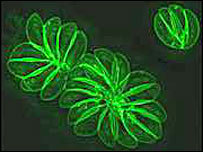The Californian researcher has called for owners to keep their cats indoors.
Cat faeces carrying Toxoplasma parasites wash into US waterways and then into the sea where they can infect otters, causing brain disease.
The parasite is familiar to medical researchers, as it can damage human foetuses when expectant mothers become infected while changing cat litter.
The most likely source of infection for sea otters is the parasite's tough egg-like stage, known as the oocyst, which is passed in the faeces of cats.
"We need to control the infections in sea otters and reduce the risk to humans by managing our cats more responsibly," said the study author Patricia Conrad of the Wildlife Health Center at the University of California, Davis.
She told the BBC News website: "That involves keeping them indoors if we can. I know that's tough; I hate cleaning cat litter boxes as much as anybody.
"But by keeping the cats indoors, we reduce the chance they're going to get infected by eating infected birds or rodents, and the chance they are going to shed their faeces outdoors."
Targeting the brain
Scientists have been documenting the deadly brain infections in otters for eight years.
It is a major cause of mortality in sea otters living off the Californian coast: Toxoplasma caused 17% of deaths in sea otters examined from 1998 to 2001.

|
| ©BBC |
| Toxoplasma gondii: At the root of the otter decline |
And individuals with moderate to severe brain inflammation were about four times as likely to die from a shark attack.
Populations of southern sea otters have not recovered since they were hunted to the brink of extinction for the fur trade in the 1800s.
Dr Conrad has found that otters are more often infected with the single-celled parasite Toxoplasma gondii near urban centres with heavy water outflow from the land.
"What appears to be happening is that cats deposit their faeces - with the parasite - on land. When rainfall comes, it washes that into waterways and the fresh water takes it into the ocean."
Once the parasite reaches the sea, it may be concentrated in mussels, oysters and clams, a major source of food for some otters.
"For the sea otters, we don't exactly know how it gets in," said Dr Conrad, "but it must be through ingestion.
"Because so many are dying, we are looking for things that concentrate the infection."
There are 73 million domestic cats in the US, and the number has doubled in the last 10 years; there are estimated to be another 78 million feral cats.
Dr Conrad was speaking at the American Association for the Advancement of Science annual meeting in St Louis, Missouri.



Reader Comments
to our Newsletter